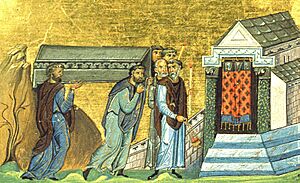Anastasius of Persia facts for kids
Quick facts for kids Anastasius of Persia |
|
|---|---|

The burial of Anastasius in the Menologion of Basil II
|
|
| Saint & Martyr | |
| Born | 6th Century Ray |
| Died | 22 January 628 Euphrates Valley |
| Venerated in | Orthodox Churches, Eastern Catholic Churches, Roman Catholic Church |
| Canonized | pre-congregation |
| Feast | 22 January |
Saint Anastasius of Persia, whose original name was Magundat, was a brave soldier from Persia. He was part of the Zoroastrian religion, which was common in his homeland. Later, he chose to become a Christian and sadly died for his faith in the year 628.
His Life and Journey
Anastasius was born in a city called Ray. His father, Bavi, was a Magi, which was a type of priest in the Zoroastrian religion.
Anastasius became a soldier in the army of King Khosrow II, who ruled Persia from 590 to 628. He was part of an important event: the capture of the True Cross in Jerusalem. This was a very important Christian relic. After it was captured, it was taken to Ctesiphon, the capital city of the Sasanian Empire.
Seeing the True Cross made Anastasius curious about Christianity. He started to learn more about the religion. This led him to change his beliefs. He left the army and became a Christian. He then joined a group of monks in Jerusalem.
He was baptized by Modestus. He received the Christian name Anastasius. This name means "resurrection" in Greek, honoring the resurrection of Jesus Christ.
After living as a monk for seven years, he traveled to Caesarea. At that time, Caesarea was controlled by the Sasanians. There, he openly spoke about his Christian faith and questioned the Zoroastrian priests. Because of this, the local governor, called a marzban, arrested him.
Anastasius was taken prisoner and faced harsh treatment. They tried to make him give up his Christian faith, but he refused. He was then moved near the Euphrates River, to a place called Barsaloe. Even there, the tough treatment continued. He was also offered high positions and honors if he would return to being a Magi for King Khosrow II.
However, Anastasius bravely refused to give up his faith. On January 22, 628, he was executed along with seventy other people.
Honoring Saint Anastasius
After his death, Anastasius's body was thrown to dogs, but they did not touch it. His body was then taken from the place where he died to Palestine. From there, it was moved to Constantinople, and finally to Rome. In Rome, his relics (parts of his body or belongings) were honored at the Tre Fontane Abbey.
A special story about his life, called a Passio, was written in Greek. An English church historian named Bede later tried to improve a Latin translation of this story.
His feast day, which is a day to remember and honor him, is celebrated every year on January 22.

